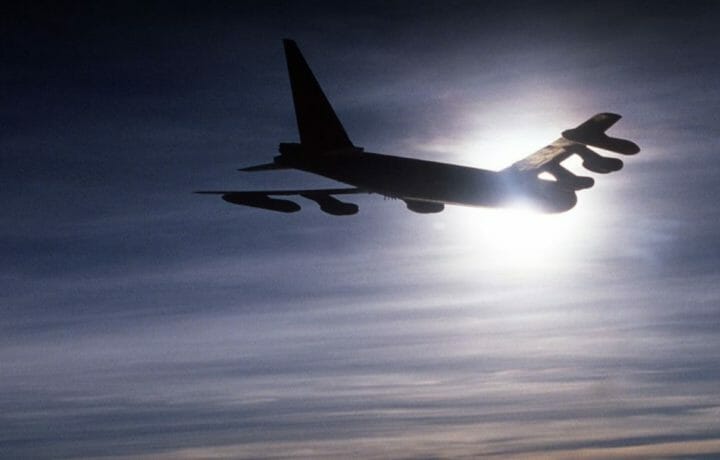The United States Air Force’s Boeing B-52 Stratofortress is the oldest American aircraft in active service today, and the Cold War-era bomber continues to log some serious miles. Earlier this week, a pair of the long-range strategic bombers assigned to the 2nd Bomb Wing flew from Barksdale Air Force Base (AFB), Louisiana to Mihail Kogalniceanu Airbase, Romania, as part of the Bomber Task Force 24-4 mission.
While already an epic trip that could test the patience of most frequent fliers, this flight was a bit longer than expected due to the unique route that took the bombers over the North Sea and then to the Barents Sea towards Finland, where they received a not-so-friendly welcome from a pair of Russian fighter planes that were sortied to intercept the bombers.
“While flying in international airspace and in accordance with international law, the U.S. B-52 aircraft were intercepted by two Russian aircraft over the Barents Sea at approximately 8 a.m. Central European Time. The U.S. aircraft did not change course due to the intercept and continued along their scheduled flight plan without incident, allowing the B-52s to perform their pre-planned mission which included integration alongside NATO fighter aircraft before landing at Mihail Kogalniceanu Air Base,” U.S. Air Forces in Europe – Air Forces Africa (USAFE-AFAFRICA) said in a statement.
As noted by the U.S. Air Force, Bomber Task Force (BTF) missions are meant to demonstrate the credibility of U.S. forces to address global security environments, which are more diverse and uncertain than ever before.
“In today’s global environment, it is vital that we be postured to deliver a range of sustainable capability from great distances. This iteration of Bomber Task Force offers an excellent opportunity to refine our agile combat employment tactics, techniques, and procedures,” said Gen. James Hecker, USAFE-AFAFRICA commander. “Through collaborative efforts with our Allies, the U.S. enables our forces to combat current and future threats.”
The Russian Reaction
Russian state media outlet TASS claimed that a Mikoyan MiG-29 (NATO reporting name “Fulcrum”) air superiority fighter, and a Mikoyan MiG-31 (NATO reporting name “Foxhound”) supersonic interceptor, were deployed to prevent the Stratofortress bombers “from violating the Russian state border.”
“On July 21, Russian means of airspace control over the Barents Sea detected a group of air targets approaching the Russian state border. In order to identify the air target and prevent the violation of the Russian state border, MiG-29 and MiG-31 fighters were raised in the air. The crews of the Russian fighters identified the air target as two B-52N strategic bombers of the US Air Force,” the Russian Ministry of Defense said in a statement.
These games of cat-and-mouse between Russian and Western aircraft have become increasingly common, especially over neutral waters including the Barents Sea, Baltic Sea, and Black Sea.
Uneventful Yet Historic Flight
Despite the length of the flight, it was otherwise largely uneventful, yet, was still historic, as it marked the first time the B-52 had flown over NATO member Finland, during which time the aircraft were escorted by Finnish F/A-18 Hornets.
The U.S. bombers also proceeded to fly over the Baltic states of Estonia, Latvia, and Lithuania, and then onto Poland, before heading to Romania, where the B-52s will operate as the 20th Expeditionary Bomb Squadron. This also marks the first time the long-range aircraft have operated from the Eastern European NATO ally’s air base. During the BTF 24-4 deployment, the pair of Stratofortress bombers will integrate with NATO allies and other international partners.
“The U.S. is dedicated to work alongside our NATO Allies and partners along the Eastern Flank to ensure we have the combined skills and coordination capabilities necessary to maintain regional safety, security, and stability,” added Hecker.
The Latest BTF – More Likely to Come
The previous BTF 24-3 deployment saw four B-52H bombers from the 69th Expeditionary Bomb Squadron from Minot AFB, North Dakota, operate from Royal Air Force (RAF) Fairford, UK.
Those B-52s arrived in the British Isles on May 20, with the first pair departing on June 18, while the second two bombers returned to the United States two days later. As reported by USAFE-AFAFRICA, such deployments serve to enable dynamic force employment in Europe, where the aircraft operate alongside NATO members and other regional partners.
In February, an undisclosed number of Rockwell B-1B Lancer bombers, assigned to the 28th Bomb Wing at Ellsworth AFB, South Dakota, arrived at Luleå-Kallax Air Base, Sweden, to train alongside Swedish Air Force aircraft as part of BTF 24-2.
That deployment, which occurred just weeks before Sweden joined the NATO alliance, was meant to integrate the U.S. bombers with the Swedish JAS 39 Gripen fighters and joint terminal attack controllers operating in the Arctic and Baltic regions. Exercises included surface attack, air interdiction, and close air support scenarios, all aimed at building partnerships and increasing readiness.
The United States Air Force is the only NATO member, and just one of three nations – along with China and Russia – to operate long-range strategic bombers.
The U.S. Air Force currently maintains a fleet of 72 B-52 bombers, 58 of which are operational and in service with the 2nd Bomb Wing and 5th Bomb Wing, while 18 more are in the reserve forces with the 307th Bomb Wing. An additional dozen are preserved in long-term storage at the Davis-Monthan AFB “Boneyard.”




